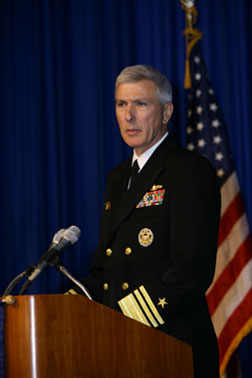 |
| Vice Adm. Samuel J. Locklear III, USN, commander, U.S. Third Fleet, describes fleet requirements in a luncheon address. |
Many forward deployed ships in the U.S. Navy are becoming independent command and control (C2) nodes as they adapt for more complex missions, according to the commander of the Third Fleet. Vice Adm. Samuel J. Locklear III, USN, told a luncheon audience that C4I is the key enabler for the fleet.
But many requirements dominate Navy wish lists: seamless communication with coalition partners; a common operational picture for sea control; adaptive security measures that are transparent to partners; more automated methods for operations; and continually available afloat networks that run at the same speed as land networks.
Adm. Locklear compared fleet operations requirements to ballistic missile defense. It requires jointness and partnership with other nations, and it also mandates that operations shift from strategic to tactical to theater. Interoperability must include coalition partners, or Navy C4I will not be as effective.
The fleet commander's top fear is an attack on satellite assets. He allowed that the military knows that other nations are considering it as a military tactic, and how the United States responds to the first strike on a satellite may determine the outcome of the rest of the conflict.




